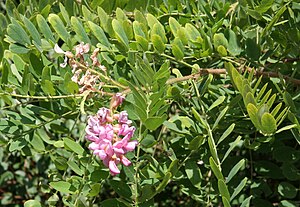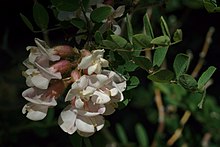New Mexico black locust
| New Mexico black locust | ||||||||||||
|---|---|---|---|---|---|---|---|---|---|---|---|---|

Inflorescence and leaves |
||||||||||||
| Systematics | ||||||||||||
|
||||||||||||
| Scientific name | ||||||||||||
| Robinia neomexicana | ||||||||||||
| A.Gray |
The New Mexico black locust ( Robinia neomexicana ) is a shrub with pink flowers from the subfamily of the butterflies (Faboideae). The natural range is in the United States and Mexico. The species is rarely used as an ornamental shrub.
description
The New Mexico black locust is a shrub up to 2 meters high with finely haired, young shoots and thorny branches. The leaves are pinnate with nine to 15 leaflets . The leaf spindle is finely haired gray. The leaflets are 1 to 4 centimeters long, finely compressed and hairy with a blunt to pointed end.
The flowers are pink in color with glandular, bristly, softly hairy stems. The fruits are up to 10 centimeters long, sparsely, but not glandularly hairy, network-nerved pods . The New Mexico black locust blooms from June to July.
distribution
The natural range is in the United States in Colorado , New Mexico , Texas , Arizona , in the south of California and Nevada and in the southwest of Utah , in Mexico in the northeast of Sonora . The New Mexico black locust grows in steppes and dry forests on dry to fresh, weakly acidic to strongly alkaline, sandy, sandy-gravelly or sandy-loamy, nutrient-rich soils in sunny to light-shady locations. The species is sensitive to moisture, loves warmth and is usually frost hardy . It is assigned to winter hardiness zone 6a with mean annual minimum temperatures of −23.3 to −20.6 ° C.
Systematics
The New Mexico-locust ( Robinia neomexicana ) is a kind of the genus of the locust ( Robinia ) in the family of the Leguminosae (Fabaceae). There it is assigned to the tribe Robinieae in the subfamily of the butterflies (Faboideae) . The species was first described by Asa Gray in 1854 . The genus name Robinia was chosen by Linné for the North American species Robinia pseudacacia , which was previously known as Acacia Americana Robini . The name refers to the French court gardener and director of the Jardin des Plantes in Paris Jean Robin (1550–1629). He is said to have brought the kind of America to France. It is more likely, however, that his son Vespasien Robin (1579–1662) raised the species from seeds that he received from America. The specific epithet neomexicana refers to the distribution area in New Mexico.
There are two varieties:
- Robinia neomexicana var. Neomexicana
- Robinia neomexicana var. Rusbyi (Wooton & Standl.) WCMartin & CRHutchins ex Peabody
use
The New Mexico black locust is sometimes used as an ornamental shrub because of its remarkable flowers .
proof
literature
- Andreas Roloff , Andreas Bärtels: Flora of the woods. Purpose, properties and use. With a winter key from Bernd Schulz. 3rd, corrected edition. Eugen Ulmer, Stuttgart (Hohenheim) 2008, ISBN 978-3-8001-5614-6 , p. 545.
- Helmut Genaust: Etymological dictionary of botanical plant names. 3rd, completely revised and expanded edition. Nikol, Hamburg 2005, ISBN 3-937872-16-7 (reprint from 1996).
Individual evidence
- ↑ German name after Roloff et al .: Flora der Gehölze , p. 545
- ↑ a b c d Roloff et al .: Flora of Woods , p. 545
- ↑ a b c d Robinia neomexicana. In: Germplasm Resources Information Network (GRIN). United States Department of Agriculture, accessed June 10, 2012 .
- ↑ Exactly: Etymological Dictionary of Botanical Plant Names , p. 540
- ↑ Exactly: Etymological Dictionary of Botanical Plant Names , p. 415
Web links
- Robinia neomexicana. In: The Plant List. Retrieved June 10, 2012 .
- Robinia neomexicana inthe IUCN 2013 Red List of Threatened Species . Posted by: Contu, S., 2010. Retrieved May 3, 2014.
